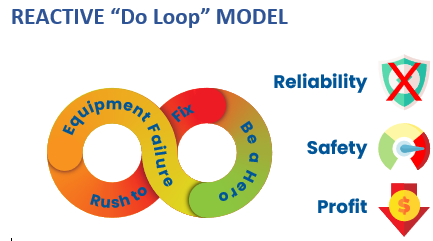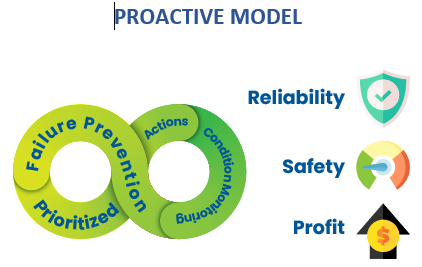Moving From a Reactive Culture To a Proactive Culture
Moving from a reactive to proactive culture is not an easy thing to do, partially because there isn’t that immediate need to jump in to diagnose a problem or an emergency fix to equipment to get the plant back on-line.
We have all been there, we get the call in the middle of the night, weekend, or turnaround. Something shut the plant down or is causing schedule delays and it is going to cost the company a lot of money unless we figure it out — now! It’s part of the job and it is fun. You gather all the needed resources, attack the immediate problem, report progress to leadership, and finally complete the quick fix while minimizing downtime. Solving the problem is an ego trip and it is rewarding. It’s an opportunity to apply all your hard-earned experience in a condensed timeframe with a high level of visibility. However, if we move on without doing a root cause analysis, developing an engineered solution, and implementing the solution in the field, it’s certain the issue will be repeated- resulting in another firefight. Management may reward you the first time you are the midnight hero, but will soon grow weary of repeat failures.
That is what we call getting caught in the “do loop” and rewarding teams for succeeding in the “do loop” cements a reactive culture. An important step in moving the dial towards preventative and proactive culture is acknowledging when we get caught in the “do loop.” It is something that should be avoided rather than it being the point of job. That way, the focus can shift to failure prevention and the culture can begin the change required for sustained reliability. Don’t worry, there will always be challenging issues that need to be resolved quickly, but in a proactive organization they are fewer and farther between, and they don’t derail sustained improvement plans. There is also a large financial reward for a proactive culture as emergency unplanned work costs about four times planned jobs. Reducing the number of unplanned emergencies also reduces the risk of a major incident and allows the organization to focus on long term improvement rather than firefighting.


Ways to help break the “do loop”
- Establish Reliability KPIs and make them everyone’s business. Reliability is important and affects safety and profitability which is what keeps us all going home safely at the end of the day with a paycheck.
- Focus on Root Cause Failure Analysis to get people asking “why” failures occur and not just “how” to fix them. RCFA can be as simple as a 5-why or as complex as a fault tree, but consistently doing RCFA’S and training staff can change the way staff approach small and large problems.
- Identify bad actors and make eliminating them a priority by setting them as goals and targets. Identifying bad actors doesn’t need to be overly complex; does it really matter if you are working on the 3rd or the 5th top item? No, what matters is that bad actors are systematically eliminated so teams can move on to preventing failures. The plant operators and maintenance personnel can identify a list of bad actors to target. Remember, if action is not taken in the field, all our effort to improve is wasted.
- Digital tools are enabling access to data so people can make better decisions ahead of failure. Digital transformation comes in all shapes and sizes but focus on where better access to data would help your team and where there is value leakage.
- Break down silos by engaging multi-discipline teams for improvement opportunities. We work in complex environments that enable the global economy to function. Rarely are failures caused by a single discipline but rather an interaction between process conditions, design, maintenance practices, and how equipment is operated. Improving reliability takes a team that is aligned on priorities and how to best keep equipment running. That cannot be accomplished by a single person.
- It’s important to address even seemingly minor deviations to processes and procedures. Most of the major incidents in the process industry have come from a cascading series of events leading to a major event.
Breaking the “do loop” means working to change culture to prevent failures before safety is compromised and money is lost. Remember to celebrate improvement and recognize the wins along way so the “do loop” gets the results we all want – Safety, Reliability, and Profitability. For more information on breaking the “do loop”, contact Becht.



